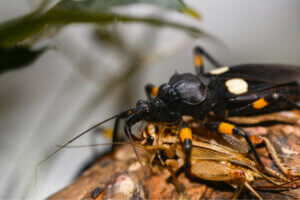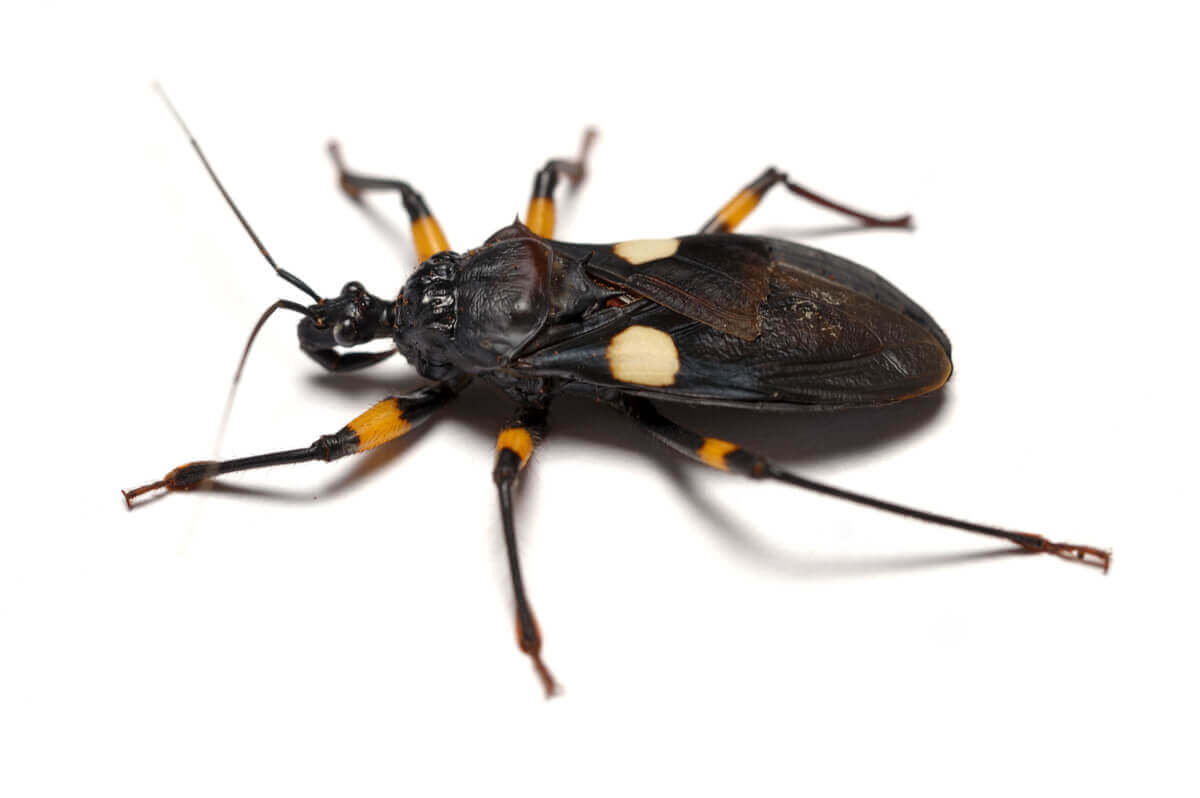Captive Care of the Two-Spotted Assassin Bug


Written and verified by the biologist Samuel Sanchez
Despite the intimidating nickname of the two-spotted assassin bug (Platymeris biguttatus), it can make a great exotic pet if you keep it in the right conditions. These invertebrates form colonies, reproduce very easily, and have truly fascinating hunting behavior.
If you’re thinking about getting a tarantula or an insect as a pet, this may be the perfect option for you. Nevertheless, we must share certain considerations regarding their captive care. If you’d like to keep a colony of these fascinating hemiptera at home, read on!
Initial considerations
The two-spotted assassin bug (Platymeris biguttatus) is native to west and southwest Africa. This friendly insect has recently become popular in the exotic animal market, as it reproduces very easily in captivity.
This species hasn’t yet been evaluated by the International Union for Conservation of Nature (IUCN). Therefore, we don’t know the current situation of its wild population. But this fact isn’t very relevant for once, as we assure you that practically all the specimens for sale come from captive breeding.
Something that you must take into account when purchasing a colony of two-spotted assassin bugs is that they’re venomous. These insects have a sharp proboscis they use to inject their prey with their toxin-filled saliva. This saliva liquefies the tissues of its victims.
If this hunting method is unpleasant to you, imagine how you’d feel if this insect bit you. Although its venom isn’t lethal, some keepers describe its bite as very painful, like getting hit with a hammer. Thus, you must be extremely careful when handling this species.

Captive care of the two-spotted assassin bug
We already warned you that this insect’s bite is no joke. But these animals aren’t aggressive, meaning they only bite by mistake or due to lack of care on the owners’ part. If you want to keep a colony of these nice hemipterans, keep reading!
Terrarium
As we mentioned above, these animals thrive in colonies. A plastic or glass terrarium that measures 11x7x7 inches in length, width, and height will allow you to keep several specimens.
When it comes to the substrate, the best option is always coconut fiber. The substrate should be five to six centimeters (2 inches) thick so that the females can lay their eggs. You should also place many hiding places and shelters with cork bark and other elements inside the facility, as this will prevent cannibalism.
Remember that any terrarium for exotic animals must have good ventilation. Thus, if you build the terrarium yourself or choose a plastic container, don’t forget to make very small holes in the walls to promote air flow.
Be careful with the diameter of these ventilation holes, as the insects can escape through them.
Environmental conditions
As they’re native to Africa, these animals are used to different temperature ranges. Here are the most important parameters you should keep an eye out for:
- Temperature. Although the ideal temperature is between 75 and 86°F, these insects resist the cold well. It’s best to fall short than to overdo it, so you shouldn’t place heating blankets or heat sources in the terrarium.
- Humidity. The relative humidity must be between 60% and 80%. To reach these levels, spray water on the terrarium substrate a couple of times a week.
- Light. Invertebrates don’t require light bulbs. In addition to this, always keep the terrarium away from direct light sources, as it could create a lethal magnifying glass effect inside the terrarium.
Diet
Without a doubt, the most fascinating part of these invertebrates is their hunting behaviors. These hemipterans pounce on their prey and pierce them with their proboscis, which kills their victim almost right away. In addition, it’s common to see several specimens fighting for prey or attacking each other.
As it’s exclusively a predatory species, Platymeris biguttatus feeds only on live invertebrates, such as crickets, worms, and cockroaches. The bigger the colony, the more insects you should feed them.
It’s best for you to offer as much prey as you can, as these animals will resort to cannibalism if they don’t have food at their disposal.
Reproduction
In the world of terrarium keeping, the idea that these animals are parthenogenetic has spread. This means that females develop embryos from unfertilized egg cells. But this isn’t the case. Females lay eggs even if they don’t reproduce, but no nymphs will emerge from them.
Therefore, for there to be multiple generations in a terrarium, you must have both males and females in the colony. The reproduction of this bug is extremely simple. If you keep the substrate with a certain humidity and the adults are well-fed, nymphs will begin to appear in one or two months.

As you may have seen, this species is extremely easy to care for. If you give it enough food and take precautions to avoid being bitten, you’ll be able to enjoy many generations of these insects without any problem.
Despite the intimidating nickname of the two-spotted assassin bug (Platymeris biguttatus), it can make a great exotic pet if you keep it in the right conditions. These invertebrates form colonies, reproduce very easily, and have truly fascinating hunting behavior.
If you’re thinking about getting a tarantula or an insect as a pet, this may be the perfect option for you. Nevertheless, we must share certain considerations regarding their captive care. If you’d like to keep a colony of these fascinating hemiptera at home, read on!
Initial considerations
The two-spotted assassin bug (Platymeris biguttatus) is native to west and southwest Africa. This friendly insect has recently become popular in the exotic animal market, as it reproduces very easily in captivity.
This species hasn’t yet been evaluated by the International Union for Conservation of Nature (IUCN). Therefore, we don’t know the current situation of its wild population. But this fact isn’t very relevant for once, as we assure you that practically all the specimens for sale come from captive breeding.
Something that you must take into account when purchasing a colony of two-spotted assassin bugs is that they’re venomous. These insects have a sharp proboscis they use to inject their prey with their toxin-filled saliva. This saliva liquefies the tissues of its victims.
If this hunting method is unpleasant to you, imagine how you’d feel if this insect bit you. Although its venom isn’t lethal, some keepers describe its bite as very painful, like getting hit with a hammer. Thus, you must be extremely careful when handling this species.

Captive care of the two-spotted assassin bug
We already warned you that this insect’s bite is no joke. But these animals aren’t aggressive, meaning they only bite by mistake or due to lack of care on the owners’ part. If you want to keep a colony of these nice hemipterans, keep reading!
Terrarium
As we mentioned above, these animals thrive in colonies. A plastic or glass terrarium that measures 11x7x7 inches in length, width, and height will allow you to keep several specimens.
When it comes to the substrate, the best option is always coconut fiber. The substrate should be five to six centimeters (2 inches) thick so that the females can lay their eggs. You should also place many hiding places and shelters with cork bark and other elements inside the facility, as this will prevent cannibalism.
Remember that any terrarium for exotic animals must have good ventilation. Thus, if you build the terrarium yourself or choose a plastic container, don’t forget to make very small holes in the walls to promote air flow.
Be careful with the diameter of these ventilation holes, as the insects can escape through them.
Environmental conditions
As they’re native to Africa, these animals are used to different temperature ranges. Here are the most important parameters you should keep an eye out for:
- Temperature. Although the ideal temperature is between 75 and 86°F, these insects resist the cold well. It’s best to fall short than to overdo it, so you shouldn’t place heating blankets or heat sources in the terrarium.
- Humidity. The relative humidity must be between 60% and 80%. To reach these levels, spray water on the terrarium substrate a couple of times a week.
- Light. Invertebrates don’t require light bulbs. In addition to this, always keep the terrarium away from direct light sources, as it could create a lethal magnifying glass effect inside the terrarium.
Diet
Without a doubt, the most fascinating part of these invertebrates is their hunting behaviors. These hemipterans pounce on their prey and pierce them with their proboscis, which kills their victim almost right away. In addition, it’s common to see several specimens fighting for prey or attacking each other.
As it’s exclusively a predatory species, Platymeris biguttatus feeds only on live invertebrates, such as crickets, worms, and cockroaches. The bigger the colony, the more insects you should feed them.
It’s best for you to offer as much prey as you can, as these animals will resort to cannibalism if they don’t have food at their disposal.
Reproduction
In the world of terrarium keeping, the idea that these animals are parthenogenetic has spread. This means that females develop embryos from unfertilized egg cells. But this isn’t the case. Females lay eggs even if they don’t reproduce, but no nymphs will emerge from them.
Therefore, for there to be multiple generations in a terrarium, you must have both males and females in the colony. The reproduction of this bug is extremely simple. If you keep the substrate with a certain humidity and the adults are well-fed, nymphs will begin to appear in one or two months.

As you may have seen, this species is extremely easy to care for. If you give it enough food and take precautions to avoid being bitten, you’ll be able to enjoy many generations of these insects without any problem.
All cited sources were thoroughly reviewed by our team to ensure their quality, reliability, currency, and validity. The bibliography of this article was considered reliable and of academic or scientific accuracy.
- Platymeris biguttatus, IUCNredlist.org. Recogido a 9 de diciembre en https://www.iucnredlist.org/search?query=platymeris%20biguttatus&searchType=species
- Walker, A. A., Robinson, S. D., Undheim, E. A., Jin, J., Han, X., Fry, B. G., … & King, G. F. (2019). Missiles of Mass Disruption: Composition and Glandular Origin of Venom Used as a Projectile Defensive Weapon by the Assassin Bug Platymeris rhadamanthus. Toxins, 11(11), 673.
This text is provided for informational purposes only and does not replace consultation with a professional. If in doubt, consult your specialist.








